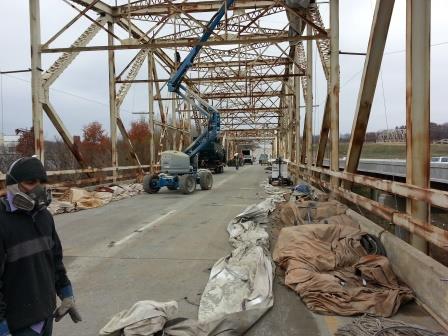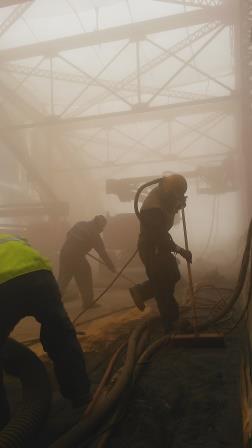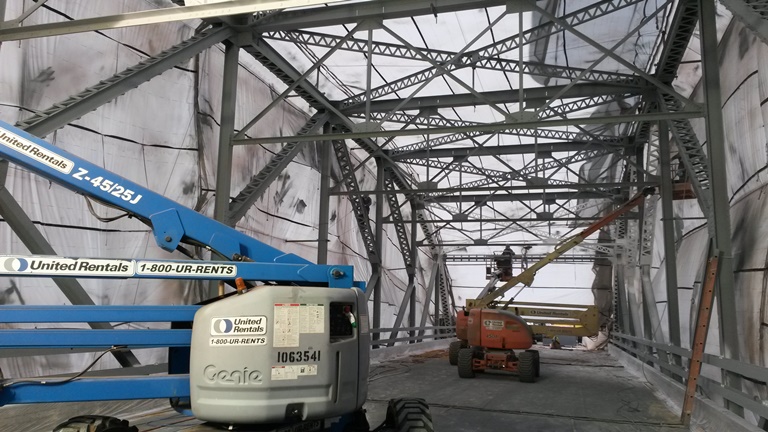The historic Route 66 runs all the way from Los Angeles to Chicago, passing through Missouri, Kansas, Oklahoma, Texas, New Mexico, and Arizona along the way. Built in 1926, it was one of the original highways in the United States. It’s known as the Will Rogers Highway and the Main Street of America, and it has inspired the “Get Your Kicks on Route 66” song as well as the Route 66 TV show.
Luke Pappas and his Tarpon Springs, Fla.-based Southern Road & Bridge crew got to take part in a small chunk of that history in November and December of 2013. But being part of that history comes with a price, and that price is rusted and deteriorated steel.
Shape Up
Pappas’s Southern Road & Bridge was chosen to refurbish and recoat a bridge over Bird Creek in Tulsa, Okla. The historic Highway 66 passes over that bridge.
“The bridge was in very bad condition,” Pappas said. “It used to be two bridges identical to each other. They dismantled one and left the other because it had historic value.”
Pappas’s company was the low bidder, so it got the job from the Oklahoma Department of Transportation, which he had never worked with before.
Before Pappas started the job, he scoped out the scene and found that the bridge was in very bad shape. It was so rusted that the steel had become compromised. “It had very deteriorated steel; we had to replace and strengthen and stiffen the steel after we blasted it,” he said.
And there was a lot of it, too. The bridge consists of 120,000 square feet (11,148 m2) of structural steel, including three pony trusses and three through truss structures totaling over 1,000 linear feet (305 m).
 The historical nature of the bridge, or more accurately Route 66, added another complication. Because the highway passes over it, the Oklahoma Department of Transportation specified that the road could only be closed for 60 days, meaning the job could only last for 60 days. Traffic was diverted to another highway in the meantime, Pappas said. “They closed the bridge, and we had 60 days to do the job,” he said. “If we went over 60 days, we had to pay a $5,000-a-day penalty.”
The historical nature of the bridge, or more accurately Route 66, added another complication. Because the highway passes over it, the Oklahoma Department of Transportation specified that the road could only be closed for 60 days, meaning the job could only last for 60 days. Traffic was diverted to another highway in the meantime, Pappas said. “They closed the bridge, and we had 60 days to do the job,” he said. “If we went over 60 days, we had to pay a $5,000-a-day penalty.”
If that wasn’t enough incentive to work quickly, there was also a bonus. “If we finished early, we were given a $5,000-a-day incentive,” Pappas said. But there was a catch: The maximum bonus they could get was for finishing 15 days early, meaning the job would last 45 days total.
Huddle Up
Pappas had his motivation and acted on it. While he usually employs 18 people, he brought on a crew of up to 25 for the job. “We had a really large crew because we knew we had to try to finish this thing early,” he said. “We were rigging out in front of the blasting crew and painting behind the blasting crew, so there was always continual work.”
 The weather didn’t make things easier either. It was November in Oklahoma, which meant it was snowing almost every day, Pappas said. “We had to build a very tight containment,” he explained. “Oklahoma weather is very unpredictable. We had snow on top of and around the containment.”
The weather didn’t make things easier either. It was November in Oklahoma, which meant it was snowing almost every day, Pappas said. “We had to build a very tight containment,” he explained. “Oklahoma weather is very unpredictable. We had snow on top of and around the containment.”
To cope, during the entire project the Southern Road & Bridge crew ran twin 1 million BTU (293 kW) heaters inside the containment. The crew also used a three-coat system by Sherwin-Williams. The first coat they put down was zinc, followed by an epoxy coat, and then a urethane coat. The primer was a ZINC CLAD III HS; it was applied at approximately 4 mils (102 microns). The second coat applied was MACROPOXY 646 FAST CURE EPOXY, and it was used at a thickness of 4 to 8 mils (102–203 microns). The finish coat was an Acrolon 218 HS Acrylic Polyurethane, which was applied at approximately 2 mils (51 microns).
The crew put the coatings down using WIWA 56:1 pumps and either 317 or 319 tips depending on the coat. They also used an ARS super unit six-nozzle all-in-one recycler to capture the spent abrasive.
Each layer was applied in one coat, although the middle coat needed serious striping, Pappas said. “That proved to be time consuming, because the truss was a lot to paint behind and lots of bolts required striping,” he said.
For safety, the crew wore 3M respirators with filters, Tyvek suits, and Bullard blast hoods.
On the job, the crew had to maintain 60° F (15.6° C) temperatures inside the containment. But it was 20° F (-6.7° C) outside. “So we would get there in morning and put on coveralls with sweaters on underneath, but then we’d come out fully sweating,” Pappas said.
They also wore hard hats, steel-toed boots, and goggles.
Ship Out
So did the crew meet their deadline? It seems they did — and then some.
 “We finished in 42 working days,” Pappas said. “And we had to open the bridge up to traffic for a whole week, from the Wednesday to Sunday of Thanksgiving. So we lost five days there.”
“We finished in 42 working days,” Pappas said. “And we had to open the bridge up to traffic for a whole week, from the Wednesday to Sunday of Thanksgiving. So we lost five days there.”
Pappas had never worked for the Oklahoma Department of Transportation before and is proud of what his team accomplished.
“It was a pretty awesome project what we did,” Pappas said. “We opened the bridge for five days during Thanksgiving, which meant we couldn’t work, and we still finished under the 45 day deadline.”
Pappas’s job on the bridge was one piece of a much larger $6 billion plan that includes nearly 2,000 highway and bridge improvement projects. But, he said, his crew worked together and pulled it off.
And if the tight deadline, snowy conditions, and crumbling steel weren’t enough obstacles to overcome, Pappas’s company earned the Society for Protective Coatings (SSPC)’s Qualification Procedure (QP) 1 and QP2 on this project. “We had auditors coming out,” he said. “It was a big project in our small company’s history. It was a big milestone for us.”
So the job on a historic bridge on a history highway ended up being historic — or at least significant — in the shorter history of Southern Road & Bridge.
